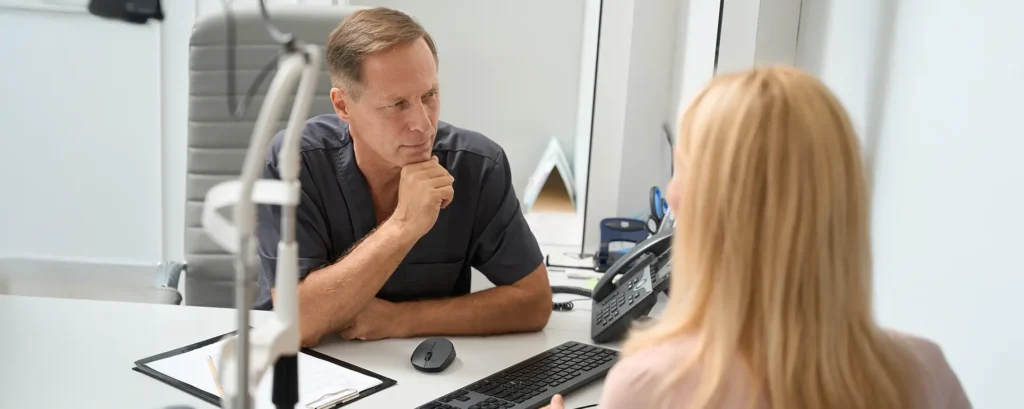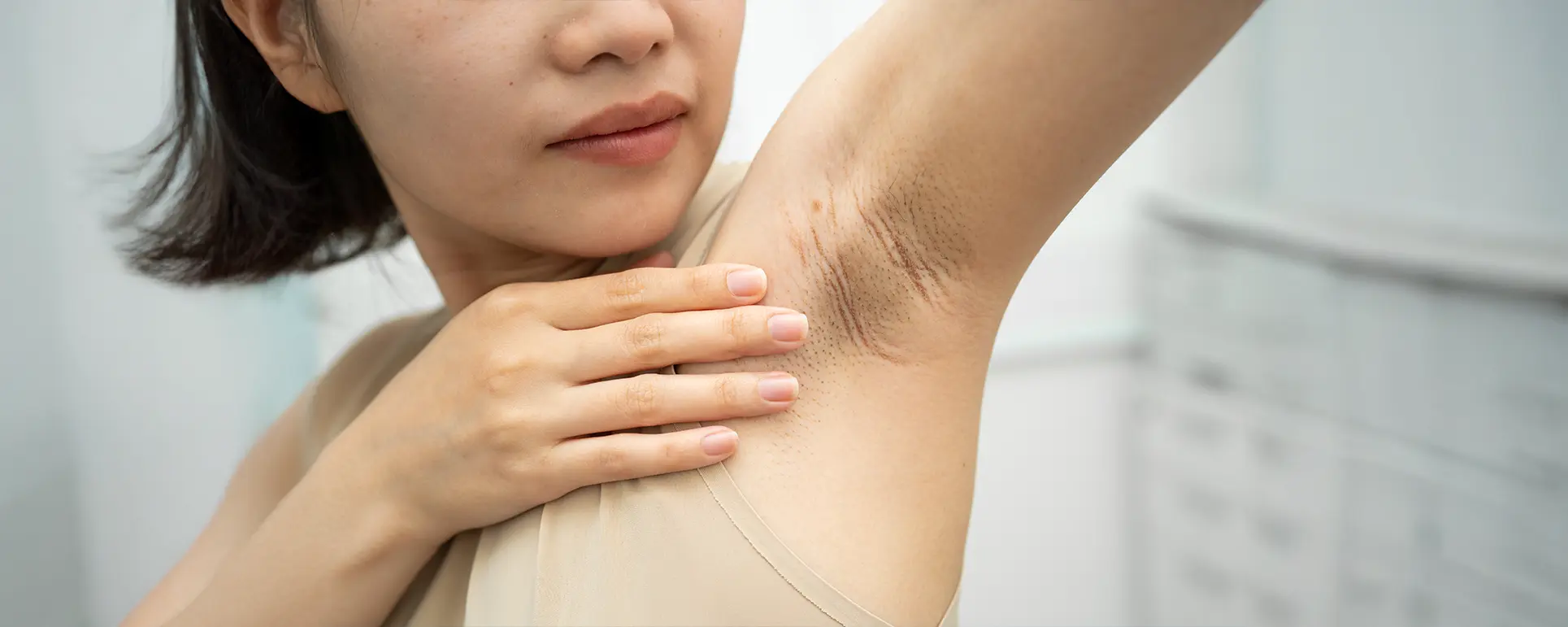It’s More Than “Just a Skin Problem”
If you’ve been struggling with painful, swollen lumps or bumps under your skin especially in areas where skin rubs together like your armpits, groin, inner thighs, buttocks, or under the breasts you may be dealing with a chronic condition called hidradenitis suppurativa (HS).
HS is often misunderstood. It’s not a simple rash, and it certainly isn’t caused by poor hygiene. It’s a medical condition, one that can significantly affect your quality of life physically, emotionally, and socially. And if you’ve been suffering in silence or feeling like you just must “live with it,” know this: It’s not your fault.
Hidradenitis suppurativa is a long-term, inflammatory skin disease that affects hair follicles and sweat glands. It causes recurring, painful boils or nodules that may leak pus, form tunnels under the skin (called sinus tracts), and eventually lead to deep scarring. These symptoms can flare up unpredictably and often worsen over time if left untreated.
Living with HS is more than a matter of physical discomfort. The condition can be extremely painful, not just during flare-ups but also in day-to-day life. Beyond the physical pain, many people feel embarrassed, anxious, or even depressed due to the appearance, odour, or chronic nature of the lesions. It can interfere with your work, your relationships, your self-esteem even what you wear and how you move.
What Is Hidradenitis Suppurativa?
Hidradenitis suppurativa (HS) is a chronic, inflammatory skin condition that affects the areas of the body where skin-to-skin contact is frequent. It typically begins after puberty and can persist for many years often worsening if left untreated. Despite being relatively common, HS is still widely misunderstood, and many people live with symptoms for years before receiving a proper diagnosis.
The condition is characterised by small, painful lumps or nodules that form beneath the skin. These are not ordinary pimples or ingrown hairs. Instead, they can grow in size, become inflamed, rupture, and leak fluid or pus. The lumps can be tender to the touch and may create a burning or itching sensation. Repeated flare-ups can lead to the development of abscesses and sinus tracts tunnel-like passages under the skin that connect different lesions. These tunnels can sometimes ooze and become infected, adding to the discomfort.
The areas of the body most commonly affected include:
- Armpits
- Groin and inner thighs
- Buttocks and perianal region
- Under the breasts
- Around the genitals or anus
- Waistline or inner waist folds
These are regions with a high concentration of apocrine sweat glands and are prone to friction, heat, and moisture factors that may contribute to the worsening of symptoms.
In some cases, HS can start with just one or two isolated lumps. But over time, without proper treatment, it can become more severe and widespread. The skin may become thickened, scarred, or discoloured due to repeated inflammation and healing.
What Does HS Look and Feel Like?
Hidradenitis suppurativa (HS) can look very different from person to person, but there are some common signs and sensations that many people share. The condition often begins with what feels like a small, tender lump beneath the skin almost like a pimple or ingrown hair. However, unlike a typical blemish, this lump doesn’t go away on its own and tends to grow larger, more painful, and more inflamed over time.
As the condition progresses, multiple symptoms can occur, including:
- Painful, red lumps under the skin: These are typically the earliest sign of HS. The lumps can be sore to the touch and feel warm or tender. They may persist for days or weeks and sometimes go away only to return later in the same spot or nearby.
- Recurrent abscesses that drain pus: The inflamed nodules can rupture, releasing pus or fluid that may have a strong or unpleasant odour. This drainage can stain clothing and cause embarrassment, especially during flare-ups.
- Foul-smelling discharge: As the lesions break open and drain, the fluid may carry a noticeable smell due to bacteria and trapped sweat or debris. This symptom can be distressing and affect a person’s confidence and comfort in social or professional settings.
- Itching or burning sensations: Even before a visible lump appears, many people feel an itch, burn, or tingling sensation under the skin. These early warning signs may indicate a flare-up is coming.
- Hard lumps or bands beneath the skin from scarring: Repeated inflammation and healing can lead to firm, fibrous scar tissue. These thickened areas, sometimes described as bands or cords under the skin, are signs of chronic, long-standing HS.
- Skin tunnelling (sinus tracts): In more advanced cases, the lumps become interconnected under the skin by sinus tracts tunnel-like formations that can fill with fluid, become infected, or repeatedly burst. This stage of HS can be particularly painful and often leads to more significant scarring and disfigurement.
The symptoms of HS are not just physical. Many people describe the condition as exhausting and emotionally draining. The unpredictable flare-ups, combined with pain, leakage, and scarring, can affect everything from personal hygiene and mobility to mental health and relationships.
Common triggers that may worsen symptoms include:
- Heat and sweating
- Friction from clothing or movement
- Stress and anxiety
- Hormonal changes (such as menstruation)
- Weight gain or certain foods in some individuals
Some people experience only occasional flare-ups, which may be months apart. Others endure constant or frequent symptoms that gradually progress over the years. In any case, the symptoms are real, impactful, and deserve to be taken seriously.
What Causes Hidradenitis Suppurativa?

The exact cause of hidradenitis suppurativa (HS) remains unclear, but research suggests it results from a combination of genetic, environmental, hormonal, and immune system-related factors. One important thing to understand is that HS is not caused by poor hygiene, and it is not contagious. It is a chronic medical condition, not something that can be caught from others or caused by uncleanliness.
At the core of HS is a problem with blocked or inflamed hair follicles, particularly in areas of the body where skin rubs together. These blocked follicles can become inflamed or infected due to the body’s overactive immune response, which causes swelling, pain, and eventually the formation of nodules, abscesses, and sinus tracts under the skin.
Several risk factors appear to contribute to the development and severity of HS:
- Genetics: HS often runs in families. If a close relative has the condition, your chances of developing it may be higher. Researchers have identified certain genetic mutations that may play a role in follicular occlusion and immune dysregulation.
- Hormonal influences: Many people with HS experience flare-ups around puberty, menstruation, or other periods of hormonal change. This has led to the belief that hormones may trigger or exacerbate the condition.
- Obesity: Excess body weight can increase the number of skin folds and areas of friction. This constant rubbing and pressure on the skin may worsen inflammation and contribute to more severe or frequent outbreaks.
- Smoking: Tobacco use is strongly associated with HS. Smokers are more likely to develop the condition, and their symptoms may be more severe. It’s believed that smoking may affect the immune system and increase inflammation in the skin.
- Autoimmune or inflammatory triggers: HS is also associated with other chronic inflammatory conditions, such as Crohn’s disease, metabolic syndrome, and psoriatic arthritis. This connection suggests that HS may have an autoimmune component, where the body mistakenly attacks its own tissues.
How Is Hidradenitis Suppurativa Diagnosed?
Hidradenitis suppurativa (HS) is typically diagnosed by a dermatologist or healthcare professional based on a thorough clinical evaluation. Unlike some skin conditions that require lab tests or biopsies, HS is most often diagnosed by simply examining the skin and discussing symptoms. That said, in some cases, a doctor may request additional tests such as blood work, swabs, or imaging to rule out infections, cystic acne, or other skin conditions that can appear similar.
During the diagnostic process, your doctor may ask a series of detailed questions to better understand your symptoms and medical history. These may include:
- When did you first notice the lumps or bumps?
Timing helps identify whether it’s a recurring, chronic issue or a new concern. - How often do flare-ups occur?
HS is characterised by recurrent episodes, so frequency and persistence are key diagnostic clues. - Do you have a family history of similar symptoms or skin conditions?
Because HS can have a genetic component, this can be an important indicator. - Have you noticed any specific triggers, such as stress, heat, menstruation, or diet?
Identifying possible triggers helps in both diagnosis and ongoing management.
The physical signs a doctor looks for include the typical locations of flare-ups (such as armpits, groin, under breasts), the pattern of lesions, and the presence of tunnels (sinus tracts) or scarring.
The Hurley Staging System
To assess the severity and guide treatment options, doctors use a classification method known as the Hurley Staging System. This three-stage system helps determine how far the disease has progressed:
- Stage 1: Single or multiple isolated abscesses or lumps. There is no evidence of scarring or tunnelling at this point, and the condition may be managed with topical treatments and lifestyle adjustments.
- Stage 2: Recurrent flare-ups with multiple abscesses that may form sinus tracts. The affected areas are more widespread, and scarring begins to develop. Treatment may involve oral medications or minor surgical procedures.
- Stage 3: The most severe form, characterised by widespread inflammation, interconnected sinus tracts, significant scarring, and chronic pain. This stage often requires more aggressive treatment, including biologic therapy or surgical intervention.
Why Early Diagnosis Matters
Prompt diagnosis is crucial because HS is a progressive condition it tends to worsen over time without treatment. Catching the disease early allows for better symptom control, less damage to the skin, and an improved quality of life. With proper management, many people with HS can minimise flare-ups and reduce the risk of long-term complications.
What Are the Treatment Options?
There’s no one-size-fits-all cure for HS but there are several treatments that can help manage symptoms and reduce flare-ups.
A. Topical Treatments
- Antibiotic creams or washes for mild cases
- Antiseptic solutions to reduce bacterial growth
B. Oral Medications
- Antibiotics (long-term) to control inflammation
- Hormonal treatments such as contraceptives or anti-androgens
- Immunosuppressants in severe cases
- Biologics (like adalimumab) to block immune pathways and reduce inflammation
C. Surgical Options
- Drainage procedures for large abscesses
- Laser therapy to reduce flare-ups and scarring
- Wide excision surgery for advanced stages
D. Lifestyle Modifications
- Weight management to reduce friction
- Quitting smoking to lessen severity
- Wearing loose clothing and using barrier creams
Working with a dermatologist helps determine the right combination of treatments based on your specific stage and lifestyle.
Living with HS: More Than Just Physical Symptoms
Living with hidradenitis suppurativa (HS) goes far beyond managing painful lumps and skin flare-ups. While the physical symptoms are often the most visible and immediate concern, the emotional and psychological toll of HS can be just as significant if not more so. This condition can deeply impact a person’s mental health, self-confidence, and day-to-day lifestyle, sometimes in ways that aren’t easily seen or understood by others.
Many people living with HS report struggling with the unpredictable nature of the disease. Flare-ups can occur without warning, causing pain, swelling, and discharge that interferes with work, sleep, exercise, and relationships. The emotional stress that builds up over time can be overwhelming.
Some common emotional and social effects of HS include:
- Embarrassment and self-consciousness:
The condition often causes lesions that drain pus or have a strong odour, which can make individuals feel embarrassed or ashamed. This can lead to wearing oversized clothing, avoiding public places, or hiding affected areas even from loved ones. - Anxiety about intimacy and relationships:
Many people with HS feel nervous or anxious about physical closeness, fearing that a partner may not understand the condition. This can create barriers to intimacy, and some may even avoid romantic relationships altogether. - Social isolation or withdrawal:
The combination of physical discomfort, embarrassment, and fatigue can cause individuals to withdraw from social activities, avoid gatherings, or miss out on meaningful experiences. Over time, this isolation can take a serious toll on one’s overall well-being. - Chronic pain and fatigue:
HS can cause long-lasting physical discomfort, and the body’s constant effort to manage inflammation can lead to extreme tiredness. This fatigue is often misunderstood and can make everyday tasks feel daunting. - Depression and frustration:
The journey to diagnosis is often slow and filled with misdiagnoses or dismissals. For many, it takes years to receive a proper diagnosis, leading to feelings of hopelessness, sadness, or anger. Living with an incurable condition can also lead to episodes of clinical depression or emotional burnout.
Support groups, therapy, and open conversations with your care team can help ease the emotional burden. Remember you are not alone in this.
Myths and Misunderstandings About HS
Let’s clear up a few harmful myths:
“HS is just bad hygiene.”
Truth: It’s an inflammatory condition, not caused by cleanliness.
“It’s rare you probably don’t have it.”
Truth: Up to 1 in 100 people may be affected, but it’s often underdiagnosed.
“There’s nothing that can be done.”
Truth: While there’s no cure, effective management is very possible.
Education is key to better treatment and less stigma.
When to See a Dermatologist

Recognising the signs of hidradenitis suppurativa (HS) early can make a big difference in how the condition progresses. If you’ve noticed recurring lumps, painful boils, or fluid drainage especially in areas like the armpits, groin, buttocks, or under the breasts it’s important not to ignore these symptoms. Even if the bumps seem small or come and go, they could be early indicators of HS.
Many people delay seeking help because they mistake the symptoms for simple ingrown hairs, acne, or minor infections. But HS is a chronic condition, and it doesn’t go away on its own. The longer it goes undiagnosed and untreated, the greater the risk of complications like scarring, sinus tract formation, and chronic pain.
Here are some signs it’s time to see a dermatologist:
- You’ve had lumps that keep coming back in the same areas
- The lumps are painful, tender, or filled with pus
- Lesions burst and drain fluid, often with an unpleasant odour
- You notice scarring, thickened skin, or tunnels forming under the surface
- Over-the-counter treatments or antibiotics haven’t helped
Final Thoughts: You Deserve Compassionate Care
Living with hidradenitis suppurativa can be isolating but it doesn’t have to be.
With the right support, personalised treatment, and proper care, you can reduce flare-ups, control symptoms, and get back to living your life.
Feel free to contact us to schedule a consultation with one of our experienced dermatologists who understands HS not just from a clinical perspective, but with empathy and respect for your experience.You’re not alone. And you’re not to blame.
References:
- Jemec, G.B.E. (2012). Clinical practice. Hidradenitis suppurativa. New England Journal of Medicine, 366(2), 158–164. https://pubmed.ncbi.nlm.nih.gov/22236226/
- Vazquez, B.G., Alikhan, A., Weaver, A.L., Wetter, D.A., Davis, M.D. (2013). Incidence of hidradenitis suppurativa and associated factors: a population-based study of Olmsted County, Minnesota. Journal of Investigative Dermatology, 133(1), 97–103. https://pubmed.ncbi.nlm.nih.gov/22931916/
- Alikhan, A., Lynch, P.J., Eisen, D.B. (2009). Hidradenitis suppurativa: a comprehensive review. Journal of the American Academy of Dermatology, 60(4), 539–561. https://pubmed.ncbi.nlm.nih.gov/19293006/
- Kromann, C.B., Ibler, K.S., Kristiansen, V.B., Jemec, G.B.E. (2014). The influence of body weight on the prevalence and severity of hidradenitis suppurativa. Acta Dermato‑Venereologica, 94(5), 553–557. https://pubmed.ncbi.nlm.nih.gov/24577555/
- Zouboulis, C.C. et al. (2015). European S1 guideline for the treatment of hidradenitis suppurativa/acne inversa. Journal of the European Academy of Dermatology and Venereology, 29(4), 619–644. DOI: 10.1111/jdv.12966. https://onlinelibrary.wiley.com/doi/full/10.1111/jdv.12966
